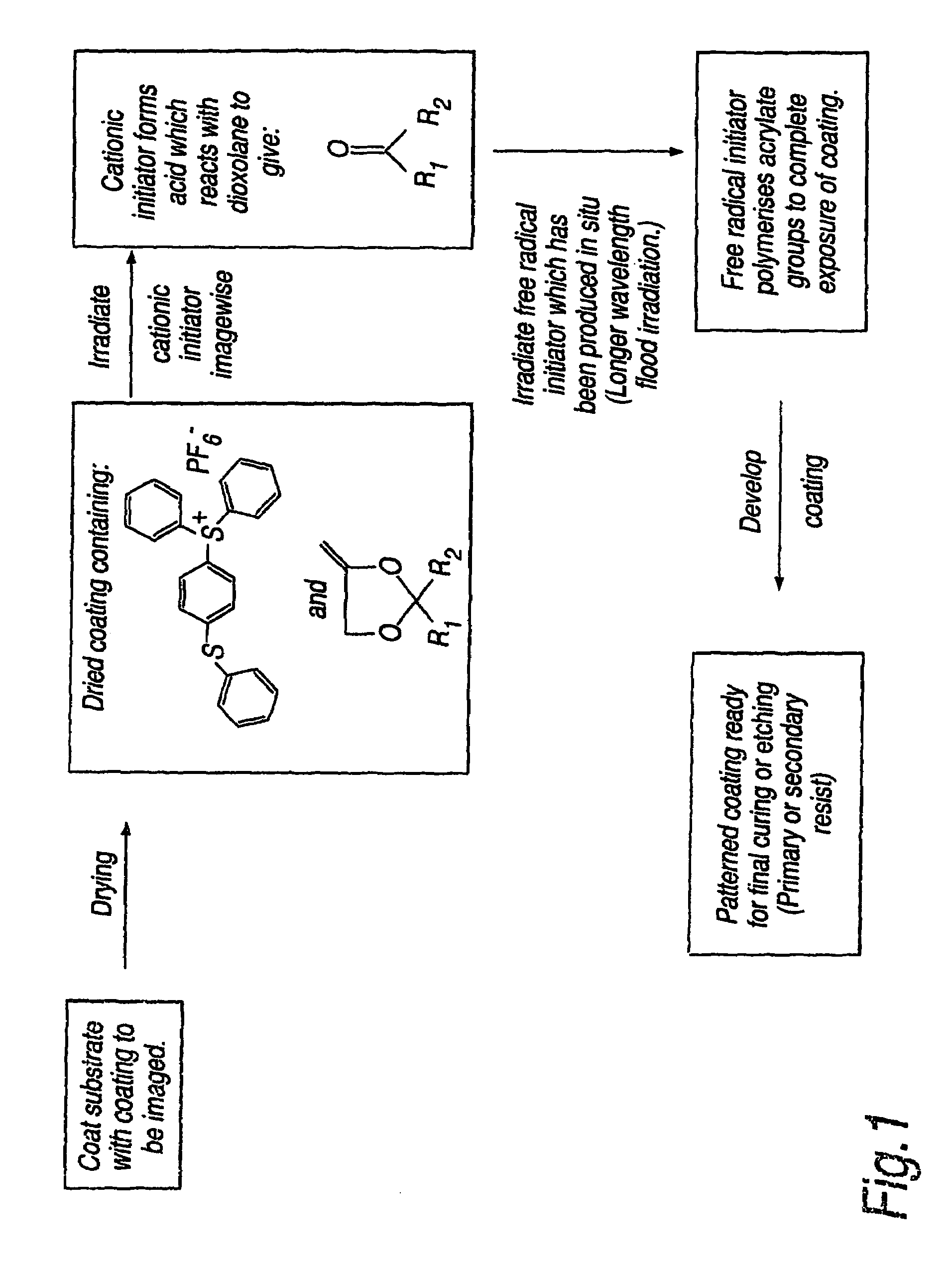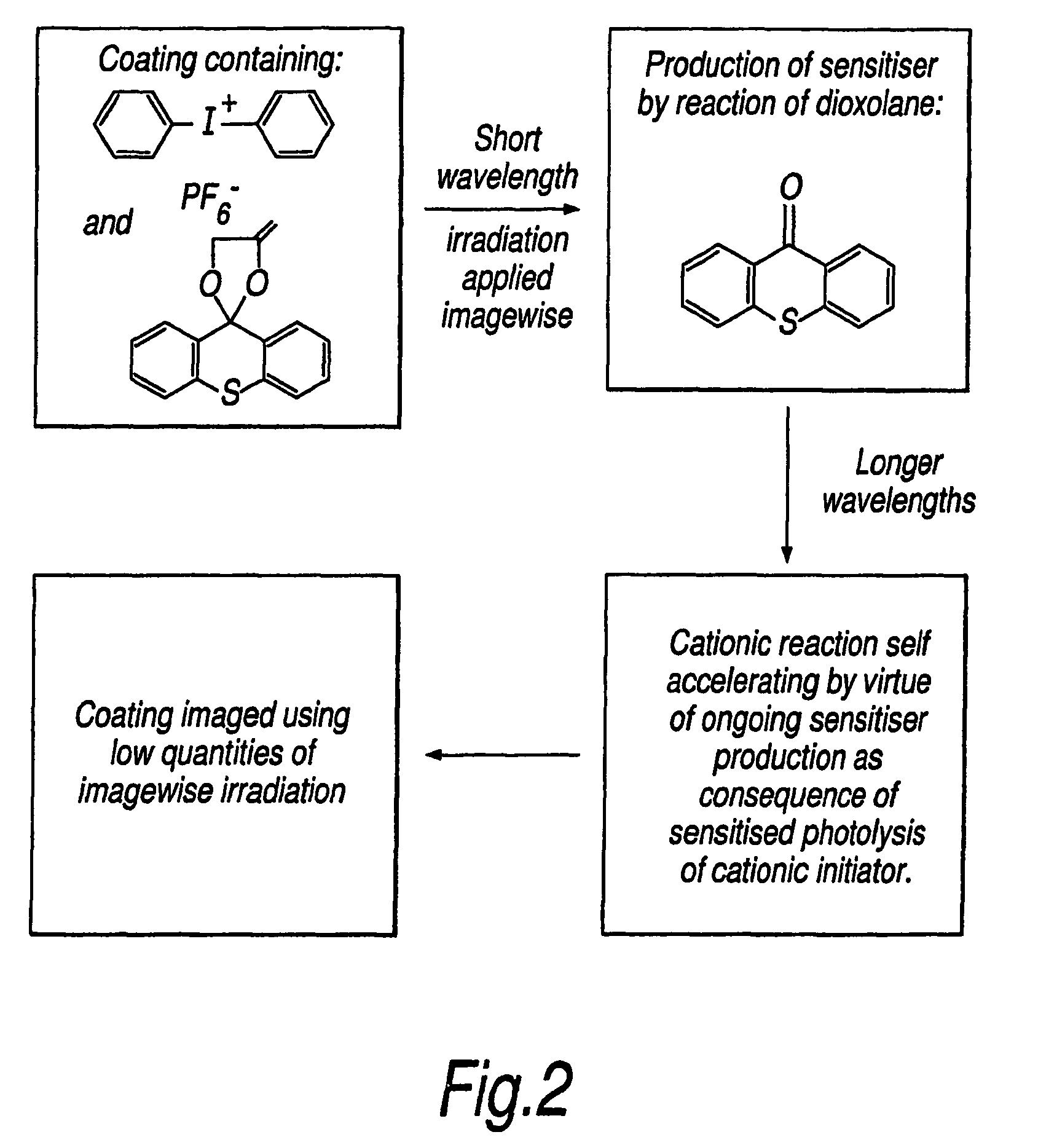Photoinitiated reactions
a photoinitiation reaction and photopolymer technology, applied in the field of photoinitiation reactions, can solve the problems of insufficient light output, inability to deliver an adequate number of photons, and inability to collimate the light output of any lamp, and achieve the effect of reducing the yield of available photons and easy delivery of random photons
- Summary
- Abstract
- Description
- Claims
- Application Information
AI Technical Summary
Benefits of technology
Problems solved by technology
Method used
Image
Examples
example 1
Synthesis of 2-phenyl-2′-[4-(4-methylphenylthio) phenyl]-4-methylene-1,3-dioxolane
[0062]Into an apparatus consisting of a 500 ml round bottomed flask equipped with a Dean and Stark apparatus / condenser, were added the following materials: 25.37 g [4-(4-methylphenylthio)phenyl]phenyl ketone, 9.21 g (+ / −)-3-chloro-1,2-propanediol, 0.25 p-toluenesulphonic acid monohydrate and 200 ml toluene. The reaction mixture obtained was heated to reflux under atmospheric pressure until the reaction was complete (water collected).
[0063]The resultant reaction mixture was cooled and washed with 200 ml molar sodium carbonate solution and then water. The organic layer was then dried over magnesium sulphate, rotary evaporated and distilled under reduced pressure.
[0064]The purified intermediate was taken and dripped into a refluxing solution of potassium t-butoxide (22 g) in tetrahydrofuran (50 g) contained in a 250 ml two necked round bottomed flask fitted with a dropping funnel and condenser. After addi...
example 2
Synthesis of di-vinyldiozolane derivative of camphorquinone
[0065]Into an apparatus consisting of a 500 ml round bottomed flask equipped with a Dean and Stark apparatus / condenser, were added the following materials: 37.4 g camphorquinone, 50 g (+ / −)-3-chloro-1,2-propanediol, 0.2 g p-toluenesulphonic acid monohydrate and 300 ml benzene. The reaction mixture obtained was heated to reflux under atmospheric pressure until the reaction was complete (water collected).
[0066]The resultant reaction mixture was cooled and washed with 200 ml molar sodium hydrogen carbonate solution and then water. The organic layer was then dried over magnesium sulphate, rotary evaporated and distilled under reduced pressure.
[0067]The purified intermediate was taken and dripped into a refluxing solution of potassium t-butoxide (50 g) in tetrahydrofuran (200 g) contained in a 500 ml two necked round bottomed flask fitted with a dropping funnel and condenser. After adding the intermediate over a period of 2 hours...
PUM
| Property | Measurement | Unit |
|---|---|---|
| weight | aaaaa | aaaaa |
| wavelengths | aaaaa | aaaaa |
| energy | aaaaa | aaaaa |
Abstract
Description
Claims
Application Information
 Login to View More
Login to View More - R&D
- Intellectual Property
- Life Sciences
- Materials
- Tech Scout
- Unparalleled Data Quality
- Higher Quality Content
- 60% Fewer Hallucinations
Browse by: Latest US Patents, China's latest patents, Technical Efficacy Thesaurus, Application Domain, Technology Topic, Popular Technical Reports.
© 2025 PatSnap. All rights reserved.Legal|Privacy policy|Modern Slavery Act Transparency Statement|Sitemap|About US| Contact US: help@patsnap.com



